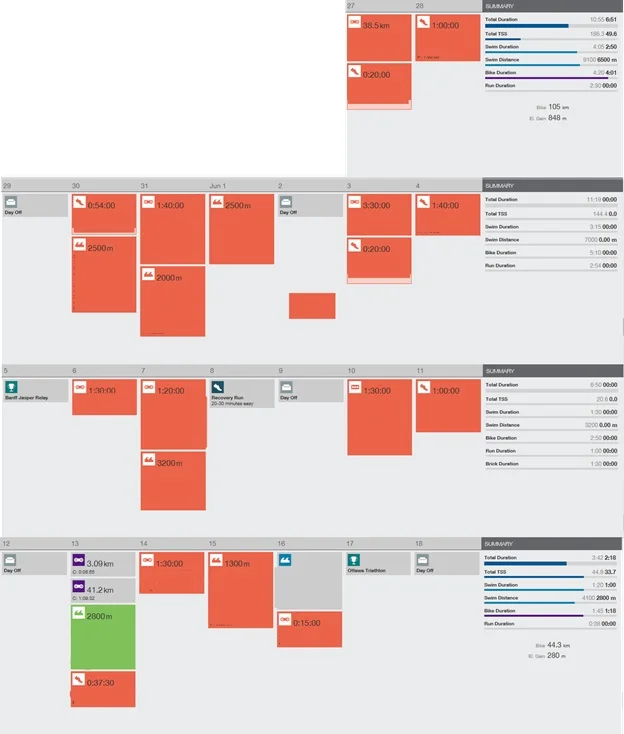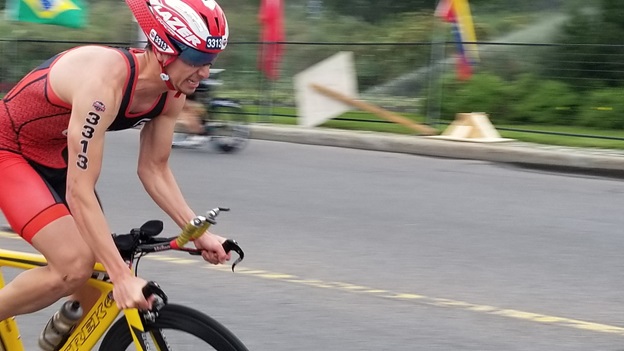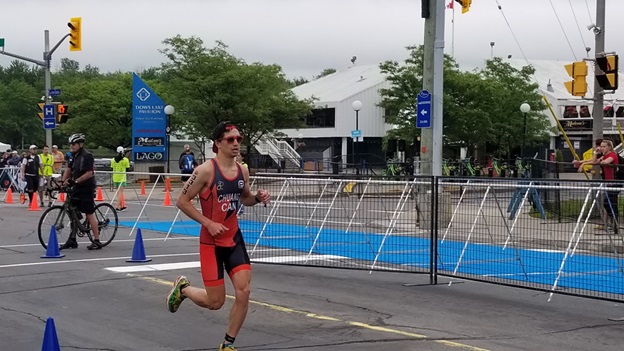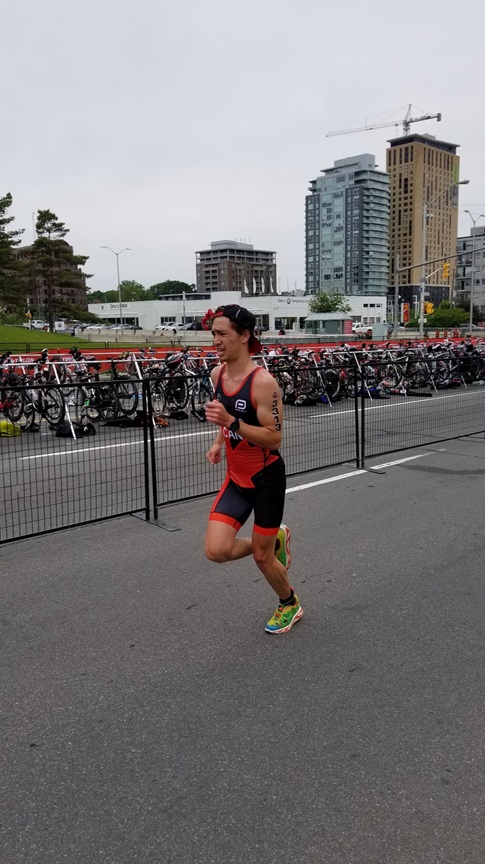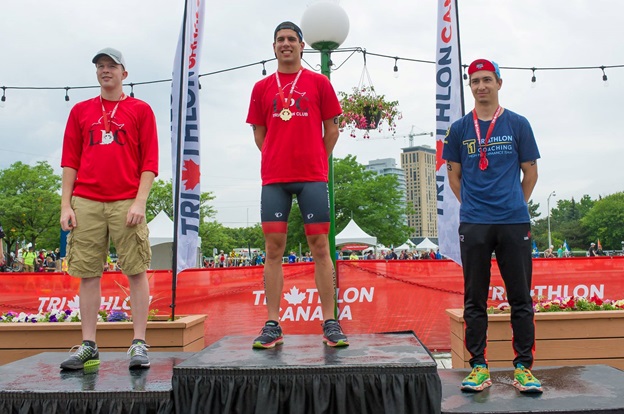Canadian National Championships Race Report - Tyler Chuang, T1High Performance Team
This is what my training schedule had looked like leading up to the 2017 Canadian Standard Distance Championships. Visibly vacant and unfulfilled. There’s a lot of incomplete (red). There was no glitch in the system, nor did my Garmin stop working. On May 16th, I felt the first pull of tightness on my IT band during a cross country workout. I made it through the workout and thought nothing of it, keeping up with my regular volume and intensity. This was my second mistake. On May 19th, I was 10 km out on my long run when a sharp pain ran down my leg and caused me to default to a limp/hobble 10 km back to the starting point. I knew my IT band was damaged, but I had no idea how bad it would turn out to be. To make matters worse, when I got back to the starting point, the gym doors were locked, with my car keys inside. I proceeded to run another 4 km home on a bum leg. The next morning I couldn’t bend my leg without excruciating pain and could not walk at all. Clearly this was not good.
Optimistic about being healthy by June 17th, I backed off the run training a bit to focus more on swimming and cycling. Every couple days I would attempt a run to make it less than 400 meters before the pain erupted again. Frustrated and with my leg not getting any better, I decided the best course of action was to fully take a break from training. There was no point pushing through the swim and cycling workouts if I wouldn’t be able to finish the race in the run. Being a stubborn KIN student I figured I could fix myself, especially since, ironically, my master’s thesis focuses heavily on the IT band and IT band syndrome. 2 weeks out from the race, I caved and visited a physio. At this point, there was nothing wrong with my functionals or gait, it was just a waiting game for the IT band to heal (which is slow due to low blood supply to the tissue).
Even as late as 2 days before the race the pain presented 5 minutes into an easy run. Not the ideal lead up to this season’s “A” race but an inevitability of this sport that I had to accept. If you over-train, you will get injured, and I feel in the 4-5 weeks leading up to my injury, looking back, I did over-train and did not give my body enough time to recover between workouts. That was my first mistake. Every session felt laborious and fatigued and I pushed through anyway, which was completely self-imposed.
Days out from the race I had an ultimatum – to compete or not compete. Clearly, I chose to compete, despite the obvious, better choice to not race on a busted leg. My race plan changed, however, from racing to do my best, to just finishing and hopefully secure a qualifying spot for team Canada for 2018. My hope was that the swim and the ride would “warm up” my leg enough to get me through a 10km jog. My only training in the preceding 21 days was a swim and bike 4 days out because I wanted to test the leg for pain. It hurt.
The swim was pretty uneventful and played out as I expected. In my first open water swim since worlds in Cozumel nearly 9 months ago, I found it hard to sight and found myself zig-zagging a bit more than I would have liked. My arms were also burning, no doubt due to the lack of swimming over the past few weeks in an attempt to completely lay off exerting my IT band and associated muscles.
Out of the water and onto the bike, BOTH IT bands felt super tight and tender during the first few km’s of the bike. This had me very worried and decided to ride the first “out section” conservatively to try to stretch out my legs a bit. The bike course was a fairly flat 2 lap out and back course along an off shoot of the Rideau canal. I love out and back courses because you can very easily gauge where you stand in the overall rankings. At the first turn around I was sitting in 15th after having passed a handful on the way out. With my hip pain subsiding, I decided to up the intensity and my short term goal was to get off the bike in the top 10. I hadn’t planned on racing tacticfully but I felt pretty good and made some strong surges to pass a few riders, especially those who I knew were in my AG. I made it up to 11th by about 30km in. When I noticed I wasn’t making up any time on 10th place, I realized I had put on cruise control. It wasn’t so much that I was tired or fatigued, but my mind seemed to have wandered.
I was more focused on the run and running through all of the possible scenarios that could have occurred and what my reaction would be. What if my leg gives out as soon as I get out of transition? Do I walk? Give up? Does my overall placing matter? Would I push through if I was in good overall contention? What happens if my IT band hurts, but the pain isn’t excruciating? Do I continue and risk permanent/season ending injury? Or do I pull back and run for damage control?
With 5km of the bike still to go, these definitely shouldn’t have been the thoughts in my head, and what brought me back to the race were 3 riders absolutely blowing by me – 2 of which I had passed long ago in the first lap. As with what I saw in my race in Cozumel, and what many others have mentioned in their race blogs for other races, this was the result of a drafting train. I will reserve my comments for another blog entry, but I was not impressed with the sportsmanship of the race, both by officials and the athletes. Two of these athletes were on the same team and all three were sitting on each others wheels closer than a UCI sprint train, which made it seem tactical.
The run was definitely the biggest unknown of the race. I did some swimming and cycling in the preceding weeks, but absolutely no running workouts, and nothing lasting longer than 20 minutes of jogging. I decided to take the first of 4 run laps super easy, not looking at my GPS and running according to feel. A few guys ran past me, but I also noticed that I was passing quite a few myself. Within striking distance at each turn around I saw one runner about 300 meters ahead from the University of Toronto, and one runner about 200 meters behind me, who I knew was from Queens. Regardless of whether they were in my age group (turns out only the guy behind me was, at this race was the University/College Championship division. With 3 university students within about a minute of each other, the pressure was on and I had a little more motivation to push through whatever was to come.
After lap 1, my IT band felt fine, so I decided to pick up the intensity and give it a go. The next lap showed approximately the same gap between the dog-chase-cat-chase-mouse mini race simultaneously going on. The splits seemed to be concretely set at every turn around. Neither of us were budging on our paces and it seemed like we were all running the exact same splits. Looking back at the results, for the second lap, we ran 8:05, 8:01 and 8:02. It was a waiting game to see who would falter first. I was eagle eyed on the two runners the whole time. For me, this was the highlight of the race. The mini-race occurring within the larger overall race was really exciting and not something that I often encounter during races. Knowing I was so far back in the overall, the three of us pushing each other kept the race honest and always on our toes waiting for an attack. The guys raced incredibly and no matter the outcome, that made the race for me.
At each turn around, we would all glance at each other to try to get a read on how the others were feeling. I hope I had a good poker face, but they both seemed rock solid. As we entered the third lap, and up the hill, I noticed the runner ahead of me look like he was struggling a bit. He was rocking side to side and taking smaller steps than I had been seeing. He also had a bit of a grimace on his face. At the same time, I noticed the gap to the runner behind me had grown slightly. Not wanting to get too excited or push too early resulting in a burn-out or irritation of my IT band, I tried my best to maintain pace and agreed to hammer home the final lap to see what was left in the tank. By the last lap, the Toronto runner was within striking distance. I made up ground on the uphill section at the beginning of the lap and sat a couple meters back to recover a bit. I waited until the final turn around to make my move. As we turned the corner, I saw him glance over at me out of the corner of my eye. Feeling confident, I didn’t look over at him. I surged past him with about 1km to go and made another surge just before the finishing chute.
The final result was 17th overall and 3rd in my age group (20-24). Initially after the race, I was ecstatic. My leg didn’t hurt during the run, however immediately after I stopped running, it tensed up and I was limping for the rest of the day. With the initial goal to just finish the race and hopefully get a qualifying spot, to come within a few minutes of my PB (*adjusted) was more than I could have dreamt of. But as with every race, I have the tendency to really overanalyze every aspect of the event. What if I was healthy? What if I pushed harder on the bike and run? What if I kept training through the injury, would it still be just as sore but my fitness way higher? Looking back from an objective point of view, it wasn’t a great race. Had I raced under better circumstances, I would be pretty disappointed.
The point of this blog, however, isn’t to make excuses or to seek sympathy, but quite the contrary. Given the circumstances, I really am happy with the result. What I have always loved about the sport is the ability to push yourself to the limits so see what is possible. To go beyond your expectations both physically and mentally. Going into the race with no certainty of if I would even finish or qualify, sneaking onto the podium was a huge surprise. The race certainly hurt, but it’s a small stepping stone to recovery. I’m optimistic and hungry for the rest of the season.

